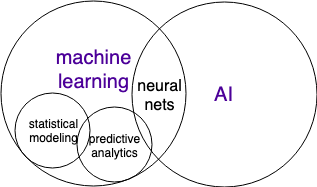AI vs ML: some definitions
After more than 3.5 years at lumo, I decided it was time to switch things up. I’m still pretty conflicted about the decision, and have all kinds of thoughts and feelings rolling around about leaving a startup that I poured so much of myself into. I hope to write about CTOing and startup-ing someday.
In the meatime, I’m now at Honey doing data science, and last week I gave a little talk about the basics of machine learning. The audience was primarily engineers with limited exposure to ML, and I wanted to explain why I keep asking all those pesky questions about the data.
Slides are here, though my slides tend to be pretty minimal, especially compared to how much I tend to talk.

One area that I covered was definitions, namely the differences between machine learning and AI, as well as where predictive analytics and statistical modeling fit into the picture. Mostly these phrases describe very similar approaches/algorithms, but they differ in the community of people who tend to use each phrase.
Machine learning covers methods that take data as input, and that automatically produce new information as output. This is pretty broad, and that’s because ML covers a lot of ground (and also maybe because I’m not great at definitions).
Artificial intelligence traditionally refers to methods/algorithms that make computers seem indistinguishable from humans. One area of AI is neural networks (aka deep learning, just more complex neural networks), which are very powerful at solving problems that humans excel at, such as problems in vision (is this picture a cat or a mouse?), and problems in natural language processing (based on this text, is the person angry or just being sarcastic?).
I like to say that AI refers to methods for solving problems that are easy for humans (like understanding that something is a joke. Computers aren’t amazing at humor (yet)), whereas ML refers to methods for solving problems that are hard for humans (like predicting housing prices).
However, these two terms (ML and AI) have merged in many ways. A lot of the most exciting work in ML over the last almost-decade has been in deep learning, which is a method that comes out of AI (it is largely useful for solving problems that humans are good at). In addition, anyone pitching their new startup will say they are doing AI even when strictly speaking they are doing very simple ML. This has caught on in the business world as well, and definitely in the media.
To round out the definitions, predictive analytics is primarily used by people coming from the business world (such as MBAs, economics, analytics) to talk about (supervised) machine learning. These groups also increasingly use the word “AI” interchangeably (especially if they are not directly building models), probably for its marketing power.
And statistical modeling is similar in that it refers to the more statistically sound machine learning methods, and is used by statisticians.